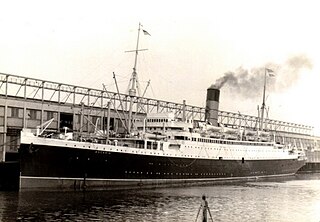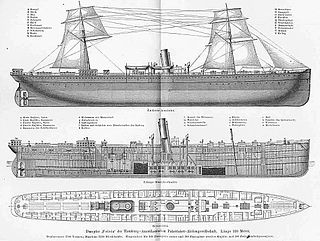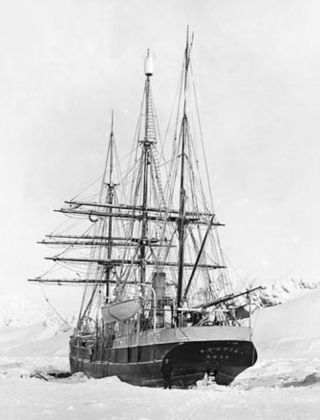
RMS Arundel Castle was a British ocean liner and Royal Mail Ship which entered service in 1921 for the Union-Castle Line. A previous vessel of the same name was built in 1864 by Donald Currie & Co. and sold in 1883, whereupon it was renamed Chittagong. Originally laid down as the Amroth Castle in 1915, building was delayed by the First World War. She was eventually launched on 11 September 1919. She was completed on 8 April 1921 and in 22 April 1921 the ship departed from Southampton on her maiden voyage to Cape Town. During World War 2 she was requisitioned by the Admiralty to serve as a troopship. After the war she resumed passenger service, eventually being scrapped in 1959.

SS Minnedosa was one of a pair of transatlantic steam ocean liners that were built in the United Kingdom, launched in 1917 and operated by Canadian Pacific until 1935. Her sister ship was Melita.
Elisabethville was an 8,851 GRT ocean liner which was built in 1921 for Compagnie Belge Maritime du Congo. In 1930 the company became Compagnie Maritime Belge. She served the Antwerp - Matadi route, connecting Belgium to Belgian Congo.
Mies was a 242 GRT tug that was built as Empire Connie in 1945 by A Hall & Co Ltd, Aberdeen for the Ministry of War Transport (MoWT). In 1946, she was sold to the Royal Netherlands Navy and renamed Mies. In 1947, she was sold to the Government of the Dutch East Indies, passing to the Indonesian Government in 1951 and then the Indonesian Navy in 1953. In 1978, she was sold and renamed Taluk Ambon, serving until 1983 when she was deleted from shipping registers.

RMS Franconia was an ocean liner operated by the Cunard Line from 1922 to 1956. The liner was second of three liners named Franconia which served the Cunard Line, the others being RMS Franconia built in 1910 and the third Franconia in 1963.

The RMS Ascania was an ocean liner operated by the Cunard Line. She was launched on 20 December 1923 at the Armstrong Whitworth Shipbuilders Ltd yard in Newcastle-upon-Tyne; the fifth of Cunard's six "A" class liners. Due to unforeseen cost overruns, the vessel was not completed until May 1925. Following service in a number of military roles during the Second World War, she was refitted and returned to civilian use in 1950, finally retiring in 1956.
Thuringia was an 11,251 GRT ocean liner that was built in 1922 by Howaldtswerke, Kiel, Germany for the Hamburg Amerikanische Paketfahrt AG, Hamburg. In 1930, she was renamed General San Martin. In 1934, she was chartered by Hamburg-Südamerikanische Dampfschiffahrts-Gesellschaft and sold to them in 1936. She was requisitioned by the Kriegsmarine in 1940 and served until 1945 as a barracks ship, and then as passenger ship during the evacuation of civilians from the Baltic.

The SS Silesia was a late 19th-century Hamburg America Line passenger and cargo ship that ran between the European ports of Hamburg, Germany and Le Havre, France to Castle Garden and later Ellis Island, New York transporting European immigrants, primarily Russian, Prussian, Hungarian, German, Austrian, Italian, and Danish individuals and families. Most passengers on this route were manual laborers, including stonecutters, locksmiths, farmers, millers, upholsterers, confectioners, and tailors, though physicians and other professionals also bought passage on her.

Eleni was a 6,112 GRT cargo ship that was built in 1947 by Lübecker Flenderwerke AG, Lübeck, Germany. She had been laid down as Greifswald for Norddeutscher Lloyd. She was captured uncompleted in May 1945 and passed to the Ministry of War Transport (MoWT), being completed in 1948 as Empire Ely. In 1954, she was sold to a Liberian company and renamed Maribella. A sale in 1955 to West Germany saw her renamed Ganges. In 1959, she was sold to Greece and renamed Eleni, serving until she was involved in a collision in 1971. She was declared to be beyond economic and scrapped in April 1972.

Scotia was a barque that was built in 1872 as the Norwegian whaler Hekla. She was purchased in 1902 by William Speirs Bruce and refitted as a research vessel for use by the Scottish National Antarctic Expedition. After the expedition, she served as a sealer, patrol vessel and collier. She was destroyed by fire in January 1916.

Empire Fowey was a 19,121 GRT ocean liner that was built in 1935 as Potsdam by Blohm & Voss, Hamburg for the Hamburg America Line. She was sold before completion to Norddeutscher Lloyd. While owned by Norddeutscher Lloyd she was one of three sister ships operating the service between Bremen and the Far East. Her sister ships were SS Scharnhorst and SS Gneisenau.
Charkieh was an iron screw steamer launched in 1865. Built at Leamouth near London, she was purchased by the Khedivate of Egypt as a mail steamer. She was in a collision in the River Thames in 1872 and was eventually wrecked off Greece in 1900.

KRI Tanjung Nusanive (973) was a troop ship of the Indonesian Navy. The ship was built at Meyer Werft, Papenburg and completed in 1984 as passenger ferry KM Kambuna of the state-owned Pelni shipping company. KM Kambuna served with Pelni until 2005 when she was transferred to the Indonesian Navy, which operated the ship until its decommissioning in early 2020.

KRI Tanjung Kambani (971) is a troopship of the Indonesian Navy. She was built in 1982 as ro-ro ferry and previously named Kobe Maru, Car Ferry Cheju No.2 and Dong Yang Express Ferry No.6.

KRI Teluk Amboina is a tank landing ship of the Indonesian Navy. The ship was built at Sasebo Heavy Industries, Japan and completed in 1961. Its design is a copy of LST-542-class LST, albeit faster than the original. As of 2020, Teluk Amboina is the oldest ship in commission with the Indonesian Navy.
KRI Teluk Peleng (535) was a Frosch-class landing ship operated the Indonesian Navy. The ship was former Lübben of the Volksmarine.










